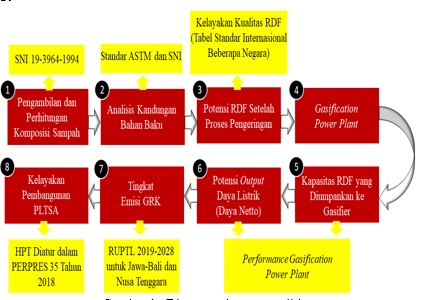Analisis Tekno-Ekonomi dari Refuse Derived Fuel (RDF) sebagai Waste To Energy (WTE) di TPA Pakusari Jember, Jawa Timur
Abstract
The problem with waste in Jember Regency is that waste management has not been maximized. The abundant availability of combustible waste can be used as RDF as waste to energy. This study analyzed the potential RDF and the feasibility of constructing a PLTSa at TPA Pakusari using the life cycle cost method and the electricity cost is calculated by LCoE. Waste management of refuse-derived fuel in order to meet the quality standards of RDF is carried out by pre-treatment in the form of sorting, enumeration, natural or mechanical drying, and sifting. The capacity of RDF is 83.762 kg/day, with a potential power generated using gasification technology of 1.000.621 Watt. The level of GHG emissions produced is 1,8 tCO2. The PLTSa project plan is equipped with an air pollution management unit. The results of the economic analysis show that the LCC value during a lifetime is Rp. 75.903.806.400. The feasibility of the Pakusari PLTSa development plan is declared feasible with a PBP value of 13 years. The NPV value with an interest rate of 8,5% is Rp. 22.065.398.707, and the IRR value is 14,35%. In the profitability index and net B/C criteria, the project is declared feasible with a value of 2,3.
Downloads
References
[2] Berita Jatim, 2021. Pemkab Jember Kesulitan Cari Lahan Tempat Pembuangan dan Pemrosesan Sampah, Jember. Tersedia Pada: https://beritajatim.com
[3] R. W. F. Dewi, M. M. S. Putra, M. S. Yudistira dan Y. Sukarmawati, “Omega cycle system solusi tepat untuk optimalisasi sistem pengelolaan sampah”, Jurnal Teoritis dan Terapan Bidang Teknik Lingkungan, vol. 1, no. 1, pp.18-29. 2020.
[4] A. E. Setyono dan N. Sinaga, “Zero waste Indonesia: peluang, tantangan, optimalisasi Waste to Energy”, Jurnal Teknik Energi, vol. 17, no. 2, pp.116-124. 2021.
[5] Suyitno, Produksi gas dari padatan : dasar-dasar, teknik, simulasi, dan aplikasi, edisi 1, UNS Press & LPP UNS ,Surakarta, 2011.
[6] BPSDM Kementerian PU, Panduan belajar: Teknologi Termal WtE Berbasis Gasifikasi, BPSDM Kementerian PU, Bandung, 2018.
[7] Undang-undang (UU) Nomor 18 Tahun 2008. Undang-undang (UU) tentang Pengelolaan Sampah. Tersedia Pada: https://peraturan.bpk.go.id
[8] D. M. Novita dan E. Damanhuri, “Perhitungan nilai kalor berdasarkan komposisi dan karakteristik sampah perkotaan di Indonesia dalam konsep waste to energy”, Jurnal Teknik Lingkungan, vol.16, no.2, pp.103-114. 2010.
[9] W. Ma, G. Hoffmann, M. Schirmer, G. Chen dan V.S. Rotter, “Chlorine characterization and thermal behavior in MSW and RDF”, Journal of Hazardous Materials, vol. 178, no. 1-3, pp.489-498. 2010.
[10] L. Puigjaner, Ed., Syngas from waste : emerging technologies, Green Energy and Technology, New York, 2011.
[11] P. J. Reddy, Energy recovery from municipal solid waste by thermal conversion technologies, energy recovery from municipal solid waste by thermal conversion technologies, London: Taylor & Francis Group, 2016.
[12] M. Azmi, “Analisis teknik dan ekonomi pemanfaatan biomassa sebagai pembangkit energi listrik di Surabaya”, tugas akhir S1, Institut Teknologi Sepuluh Nopember, Surabaya, Indonesia. 2014.
[13] A. Molino, S. Chianese dan D. Musmarra, “Biomass gasification technology: The state of the art overview”, Journal of Energy Chemistry, vol. 25, no. 1, pp. 10–25. 2016.
[14] A. Akhdiyatul, E. Radwitya dan Y. Chandra, “Analisis teknis dan ekonomis dalam penggunaan bahan bakar biomassa di pusat listrik tenaga uap studi kasus di PLTU PT. Suka Jaya Makmur”, ELKHA, vol. 10, no. 2, pp. 49-55. 2018.
[15] D. Friedman, “Levelized cost of electricity renewable energy technologies”, Fraunhofer Institut for Solar Energy Systems Ise, vol. 22, no. 1, pp. 99–131. 2013.
[16] Haiqi-Machine. Biomass Gasification Power Plant. Tersedia Pada: http://www.haiqi-machine.com
[17] E. Warman, N. A. Purba dan F. Fahmi, “Planning of Garbage Power Plant (PLTSa): Case in Medan City”, dipublikasikan di International Conference of Science, Technology, Engineering, Environmental and Ramification Researches (ICOSTEERR), 2018.
[18] S. Ma’arif, R. J. Sari, dan M. Syamsiro, “Studi kelayakan ekonomi pembangunan PLTD sistem dual fuel dengan gasifikasi sekam padi kapasitas 50 kVA”, J. Mek. Sist. Termal, vol. 1, no. 1, pp.26-31. 2016.
[19] D. S. Primadita, “Perancangan model pengolahan sampah menjadi energi listrik sebagai solusi permasalahan sampah di Kota Denpasar”, tugas akhir S1, Universitas Udayana, Badung, Indonesia. 2020.
[20] Peraturan Presiden (PERPRES) no. 35 Tahun 2018. Percepatan Pembangunan Instalasi Pengolah Sampah Menjadi Energi Listrik Berbasis Teknologi Ramah Lingkungan. Tersedia Pada: https://peraturan.bpk.go.id
[21] L. A. S. Widyaputri, “Analisis ekonomi pembangkit listrik tenaga sampah dan manfaat reduksi emisi karbon di tempat pengolahan sampah terpadu Bantargebang”, tugas akhir S1, Institut Pertanian Bogor, Bogor, Indonesia. 2014.
[22] A. P. Economopoulos, 2009. “Technoeconomic aspects of alternative municipal solid wastes treatment methods”, Waste Management Journal, Tersedia Pada: www.elsevier.com/locate/wasteman.
[23] Badan Standardisasi Nasional, SNI 19-3964-1994 : Pengambilan dan pengukuran contoh timbulan dan komposisi sampah perkotaan, Standar Nasional Indonesia, pp. 1-16, 2019.


This work is licensed under a Creative Commons Attribution-NonCommercial-NoDerivatives 4.0 International License.

This work is licensed under a Creative Commons Attribution 4.0 International License




